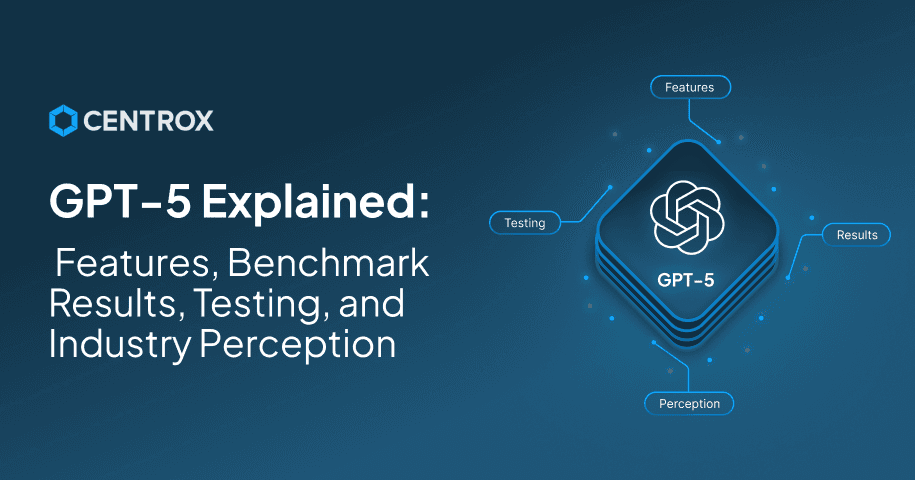GPT-5 Explained: Features, Benchmark Results, and Industry View.
Learn more about GPT-5, its features, advancements, benchmark scores, and top use cases for smarter business decisions.
8/8/2025
artificial intelligence
7 mins

The race to introduce new, helpful, high-performance AI models that dominate the benchmark leaderboard is heating up. GPT-5 is one such effort recently rolled out by OpenAI to serve this purpose, and contribute towards smarter execution of routine workflow.
The world is now looking for efficient, accurate, and intelligent AI solutions that can assist workflows by automating them. GPT-5 is launched to cater to the evolving demands across different industries, be it coding, higher-level complex academics, expert-level math, or agentic browsing or search.
With our article, we will dive deep into knowing GPT-5, how it works, its features, and performance for benchmarks, and the industry's perception of it. This will help you understand how this GPT-5 can be helpful for your business growth.
GPT-5
GPT-5 is a model released by OpenAI on August 7, 2025. This is the most advanced model released to power coding, expert-level problem solving and reasoning, along with multimodal understanding, which enables a more adaptive AI solution that provides smarter and precise responses.
GPT-5 Features
GPT-5 holds its unique features that enable it to perform the expected responsibilities. This upgraded model can now help users in streamlining their everyday workflow, and help them execute it more smartly and efficiently. Below, we list some key features of GPT-5 so that you can have a clear overview of it:

1. Personalization & Increased Context Length
GPT-5 has the ability to adapt its responses according to the preferences of the user's tone, style, and depth. It offers a large contextual length of 128k in ChatGPT and 400k via API to ensure the conversation remains consistent over a particular subject.
2. Efficiency & Speed
This GPT-5 offers a nice blend of efficiency and speed, as it contributes ultra-fast responses by consuming minimum resources. Through this, it ensures smooth usability for enterprises, developers, and everyday users without compromising accuracy and reliability.
3. Streaming
The GPT-5 model has a real-time, token-by-token response, which creates a smoother interactive conversation experience, making it ideal for being integrated into live applications like customer support, teaching, and coding, where immediacy enhances the user experience.
4. Function Calling
Through its Function calling feature, this GPT-5 connects external APIs or functions with third-party systems. It eventually contributes to automation, integration, and dynamic workflows in the research and software development environment.
5. Structured Outputs
By generating highly structured output in a machine-understandable format like JSON, it helps with clean integration with applications. This feature extends the capability to make data validation, parsing, and workflow automation, and eventually makes outputs business-ready.
6. Distillation
This GPT-5 model allows knowledge distillation to create smaller and efficient models that use its base knowledge. With its lighter versions, it still upholds the performance standards like accuracy and reliability, while supporting deployment for a restricted resource environment.
What's New in GPT-5?
Despite the feature enhancement of GPT-5, the real question that comes to mind is around the new addition this upgraded model is bringing in. So to answer your query, this GPT-5 model has announced some tool integration and multimodal expansion to optimize the research, planning, and implementation of your workflow:

1. Web Search
GPT-5 connects to live web data, providing real-time answers beyond its training knowledge. This keeps insights current for research, analysis, and fast-moving industries.
2. MCP (Model Context Protocol)
Supports secure, standardized communication between GPT-5 and tools or agents. MCP enables complex multi-system workflows, making the model collaboration-ready for advanced enterprise ecosystems.
3. File Search
Can scan, retrieve, and summarize content across user-uploaded documents. This makes it invaluable for research, project management, and enterprise knowledge handling.
4. Code Interpreter
Executes mathematical calculations, processes files, and generates data visualizations. Perfect for technical users, analysts, and educators, it adds computational power within conversations.
5. Image Generation
Transforms text prompts into visuals, enabling design, marketing, educational, and creative workflows. By uniting language and imagery, GPT-5 expands creative potential in various industries.
6. Multimodal Expansion
This GPT-5 offers advanced handling of text, images, and code within the same conversation, which allows seamless cross-modal understanding, like analyzing an image and generating code for its implementation.
GPT-5 vs. GPT-4.5 Vs GPT-4: Benchmark Results Comparison
The journey of evolution from GPT-4 to GPT-4.5 and now GPT-5 indicates that these models are progressing in reasoning, coding, math, and knowledge understanding. With each new model coming in, they are making a conscious effort to improve their capabilities beyond benchmark scores, but to improve the context window and reliable outputs. Below is a benchmark comparison highlighting how GPT-5 and previous versions perform across key areas:
| Benchmark | GPT-5 | GPT-4.5 | GPT-4 |
|---|---|---|---|
| MMLU (General Knowledge) | 87% – Near expert-level across multiple domains | 88.7% – Stronger grasp of nuanced topics | 86.4% – Solid performance across academic subjects |
| Math (GSM-8K) | 94.6% – Almost flawless problem-solving | 93%– More consistent and fewer errors | 92% – Reliable at grade-school math |
| Code (HumanEval) | 74.9% – High-quality code generation with strong reasoning | 38.0% – More robust, fewer logic bug | 67% – Decent coding but limited |
| Reasoning (DROP) | 86% – Complex multi-step reasoning done effectively | 83.4% – Better logical chain handling | 81.4% – Handles structured reasoning |
| MATH (Advanced Math) | 92.1% – Handles complex and abstract math better | 36.7% – Noticeable improvements | 69.69% – Struggles with higher-level math |
| GPQA (Graduate Physics) | 85.7% – Significant progress, but still not perfect | 71.4% – Some improvements in STEM | 32% – Weak on physics reasoning |
Benchmark Comparison: GPT-5 vs. GPT-4.5 vs. GPT-4
With the above benchmark results, it is evident that GPT-5 has significantly enhanced its AI capabilities. Where GPT-4 emerged as a foundation, and GPT-4.5 extended transitional enhancement, now GPT-5 establishes new standards for superior reasoning, coding, and mathematical performance. This GPT-5 has shown the ability to manage longer context and ensure more structured workflows for real-world applications.

GPT-5’s Best Use Case
With all these advancements, the real question is, what is the best use case of GPT-5? While GPT-5 has shown promising performance for various tasks, it has shown a relatively more powerful performance for analyzing and reviewing lengthy contracts.
Through its massive context window and advanced legal reasoning, it reliably extracts all the obligations and risk factors, and accordingly maps them onto a relevant clause of compliance standards. Eventually, making GPT-5 the most accurate and fastest model for executing duties like contract analysis.
Limitations of GPT-5
Despite all these feature enhancements and improved benchmark scores, users have experienced some performance limitations in this GPT-5 model in certain areas. Therefore, businesses must have prior knowledge of these limitations so that they can make informed decisions before integrating them into their workflow. For your help, we have mentioned some key limitations of the GPT-5 model:
1. Performance Instability & Routing Issues
Many users have noticed inconsistent behavior of GPT-5 due to the automatic model routing, which resulted in underperformed or strange output production.
2. Less Informative and Rigid Outputs
Users have experienced less nuanced and less creative responses generated through this newly introduced GPT-5 model, especially when they were using it for brainstorming complex ideas.
3. Fact-Checking & Hallucination Issues
Despite making efforts for improvements, GPT-5 has still shown factual errors and hallucinations, like misidentifying the current U.S. president, which eventually undermines users' trust in sensitive or high-stakes contexts.
4. Coding Quality Trade-offs
Although GPT-5 performs well for technical reasoning but it still falls behind models like Claude in terms of producing coding accuracy. Some users have experienced that irt generates redundant or verbose code and occasionally hallucinate on logic.
Is GPT-5 a Valuable Addition?
GPT-5 has introduced major advancements for handling diverse tasks like reasoning, coding, and problem-solving performance across benchmarks. For businesses, it extends more accurate automation, better decision support, and enhanced customer interactions.
However, before making any decision for its integration, it's important to mindfully consider these applications, such as computational costs, occasional hallucinations, and residual biases. This will help you make informed and planned decisions, reducing the chances of un solutions unexpected behaviour.
GPT-5 represents a significant step forward in AI development, providing enhanced context handling, advanced reasoning, and versatile tool integrations. Its ability to manage larger inputs allows for more comprehensive analysis and detailed interactions.
While GPT-5 is not fully autonomous and demands human oversight for critical processes, its strengths in scalability, advanced reasoning, and contextual understanding make it a valuable tool when integrated responsibly. By making the right balance between benefits and proper safeguards, businesses can step into a new world of efficiency and redefine innovation gains.
Do you think GPT-5 has the potential to empower your business solution? Discuss with our expert engineers at Centrox AI, and explore innovative ways to unlock productivity and business growth.

Muhammad Harris
Muhammad Harris, CTO of Centrox AI, is a visionary leader in AI and ML with 25+ impactful solutions across health, finance, computer vision, and more. Committed to ethical and safe AI, he drives innovation by optimizing technologies for quality.
Do you have an AI idea? Let's Discover the Possibilities Together. From Idea to Innovation; Bring Your AI solution to Life with Us!
Your AI Dream, Our Mission
Partner with Us to Bridge the Gap Between Innovation and Reality.
